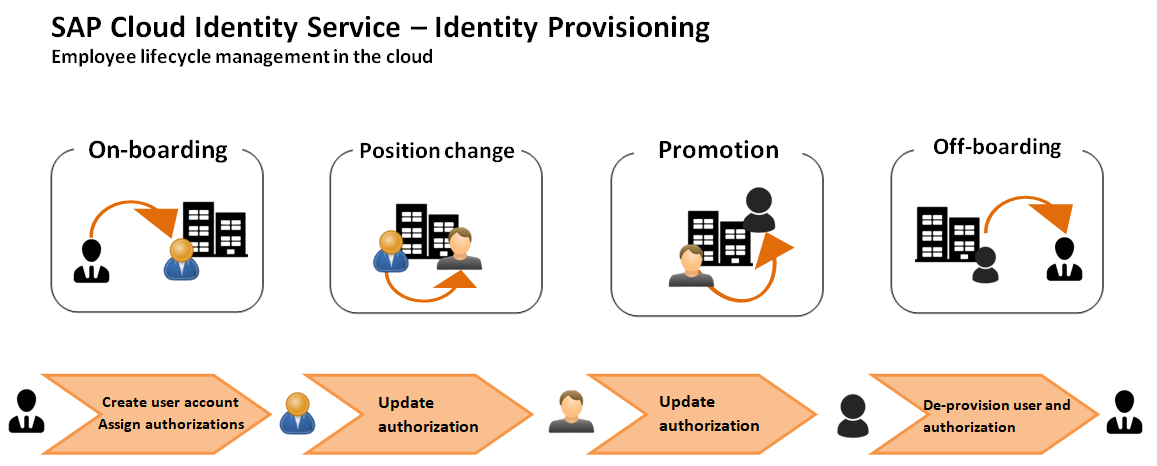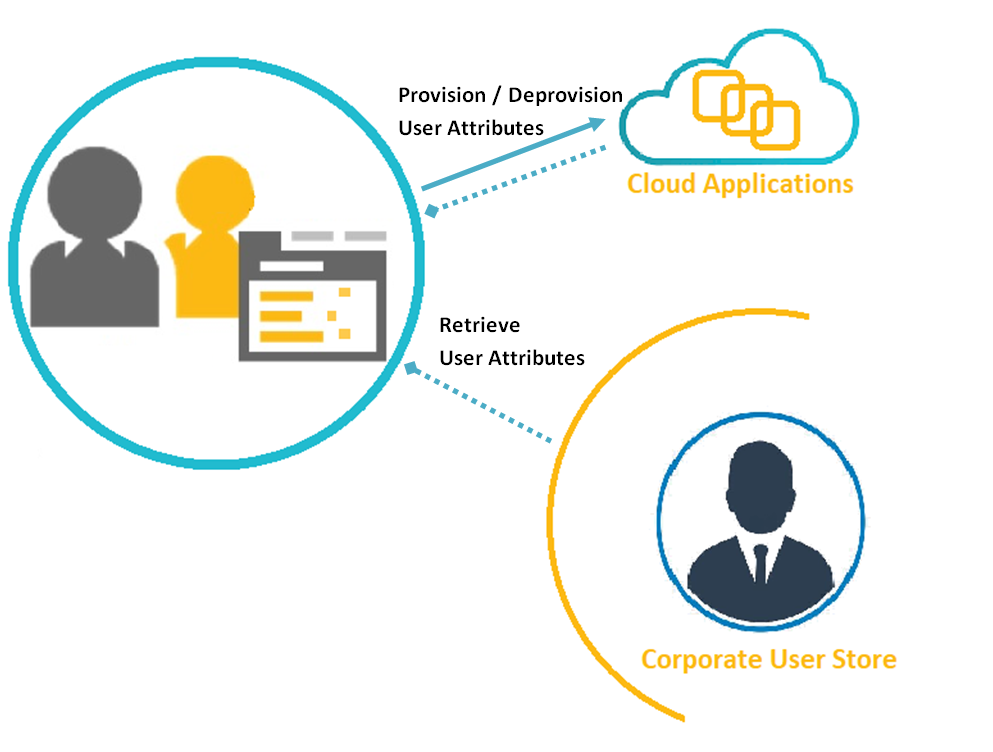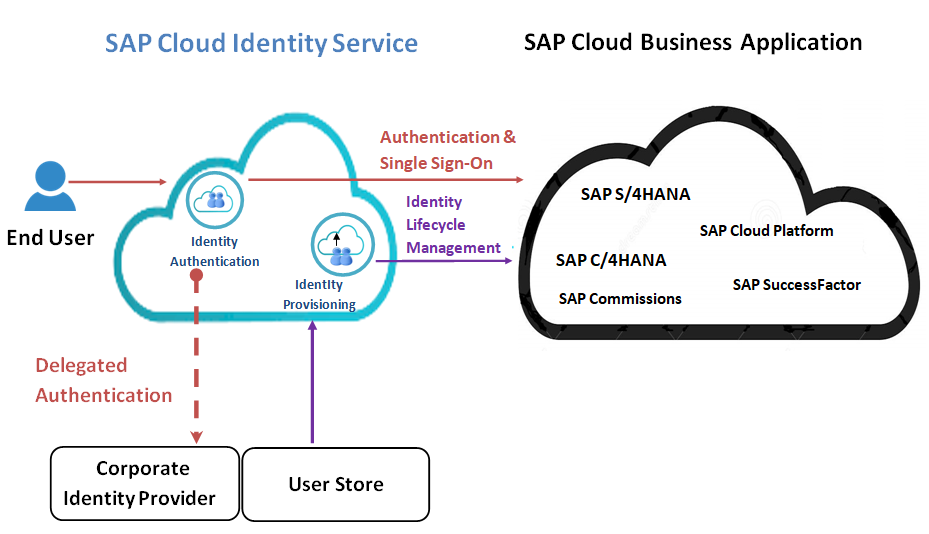Every large enterprise management system requires a security posture that takes care of the digital identity management and user security towards privileges and access controls. In SAP, this is done by Identity Provisioning. This tutorial will give you a quick walkthrough on what identity provisioning is, what are its modes, and its uses in cloud-based system.
What is Identity and Access Management?
Before digging into Identity provisioning, it is essential to understand the concept of IAM. Identity and Access Management (IAM) is simply a way to authenticate and grant access to particular data, systems, or applications in an organization. An important branch of IAM is known as identity provisioning. It takes care of the management, creation, and deletion of specific user profiles or accounts depending on the level of the identity lifecycle, such as commencing a job role, changing positions, quitting a job, amongst others.
Identity and Access Management (IAM) acts as a business framework that helps manage digital identities, their provisions, processes, and policies. IAM solutions render admins to regulate user access plus manage user identities within an organization's network. This overall security solution can protect the digital identity and maintain the sensitivity of the data within the organization.
What is Identity Provisioning?
Identity provisioning ensures proper supervision of user catalogs and accounts and oversees authorized access to the appropriate resources and utilizing them properly. In this article, we will discuss what SAP identity provisioning (IPS) involves in SAP security.
What is SAP Identity Provisioning service?
SAP Identity provisioning service (IPS) is simply a service that provides a secure and easy technique for overseeing identity lifecycle in the cloud. IPS service facilitates you with the authority to give or restrict users' licenses to business applications that are in the cloud. It gets conducted by utilizing the individual data obtained from a prevailing fundamental user store. IPS helps you in the management of identity lifecycle phases for cloud systems that leverage SAP for their enterprise-related work.
The only environment that IPS runs on is SAP BTP and Neo environment. It assists you by providing user profiles, accounts, and their various authorizations to respective cloud business applications, which may also be on-premise.

Types of SAP Identity provisioning services:
The SAP Identity provisioning services come in a bundled version only. The full version was wiped out away from the price list, simply because Identity Provisioning is a service meant to target identity lifecycle management for cloud products on SAP. A full version could be received only through access from licensing Identity Access Governance. This implies that users who want to target ABAP or S/4HANA would need to utilize the service of an old stand-alone tenant; this standalone tenant is no more accessible from SAP.
IPS makes it easy to de-provision user identities and their authorizations in different IT terrains. It helps the user to determine the regularity of the provisioning scheme depending on the specific business conditions. Another thing that makes SAP provisioning service special is its strict implementation and execution of policy-based authorization management. The IPS is limited in capacity when it comes to functionalities such as processing approval, workflows, and executing a deeper logic. To carry out these functionalities, SAP Identity Management (IdM) is used.

SAP Cloud Identity services:
SAP's Cloud Identity Services comes with two key ingredients - SAP Identity Provisioning Service (IPS) and SAP Identity Authentication Service (IAS). They are made available from the SAP Cloud Business Technology Platform (BTP). This platform is a platform-as-a-service (PaaS) offering a robust working development & runtime environment for cloud apps.
It runs on the open standards model. BTP caters to developers with the flexibility & control over SAP-based clouds, apps that require deployment, and frameworks. IAS and IPS act as core services to BTP. These services also work as complementary add-on bundles that come along with many SAP products.

Real-time provisioning on the SAP Cloud:
Provisioning entities from IAS gets eliminated for individual target systems without renouncing a scheduled job. Real-time provisioning enables the easy distribution of recently created or up-to-date users even without manually running a job or having to wait for a scheduled job.
Real-time provisioning can be effective in scenarios where there is a requirement of synchronous provision or instantaneous system access, a common example is when users carry out self-registration. It could also come in handy when there is a need to rebuild single or multiple entities in SCIM API or the IAS administration followed by instant synchronization to be carried out for individual target systems.
Proxy mode in SAP IdM:
A unique type of connector for hybrid scenarios is the proxy mode. It implies that provisioning entities or components to a superficial system that can't be established normally on SCIM can be carried out easily without establishing an explicit connection between each system. SAP security can easily accomplish this by adding an Identity Proxy connector for it to act like a SCIM 2.0 endpoint and use the API affiliated to it.
The SAP Identity Management (IdM) on-premise can be used to link the import functionality with a proxy connector. To do this, the steps are:
- To take is to make sure that the setup of the system is downloaded directly to the IPS.
- Then we have to ensure that it is properly imported into SAP IdM as a different repository.
- Finally, we prepare for the execution of the preliminary load jobs that can be done in SAP IdM to import the system. The system can now be utilized in SAP IdM just like other system kinds.
Local identity directory:
A component of SAP IPS is the local identity directory. It gives companies a directory for documenting and organizing several users and organizations in the SAP Cloud Platform. Although, it is impossible to sight data or make any modifications to data from this system by using user interfaces.
Features of Identity Provisioning:
- Users can choose from multiple supported systems: This system helps in provisioning users & groups connecting various business applications that you can append as the source and target systems.
- SAP's Identity provisioning users can leverage the default system transformations as well as modify them for changing the transformation logic as per the business needs.
- Such solutions also help in running a provisioning job manually or allow establishing a time interval so that it can automatically schedule its jobs.
- When a job failed to execute successfully, SAP users can view the logs directly from the system in the user interface. These logs help in exactly identifying users which entities have failed and why.
Conclusion:
SAP's identity provisioning system is one of the best tools that help in creating, managing, and deleting digital identities for the employees and customers within the organization. Every organization should reap the benefits of having SAP identity provisioning for better password management, compliance, authorization, provisioning, and de-provisioning.